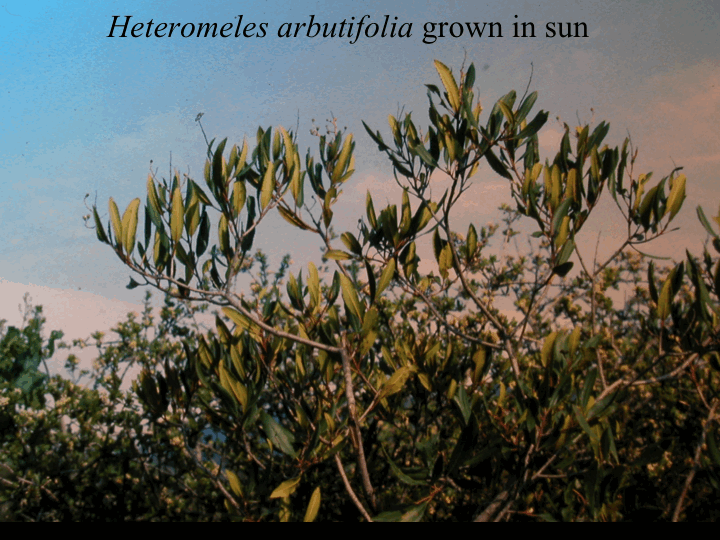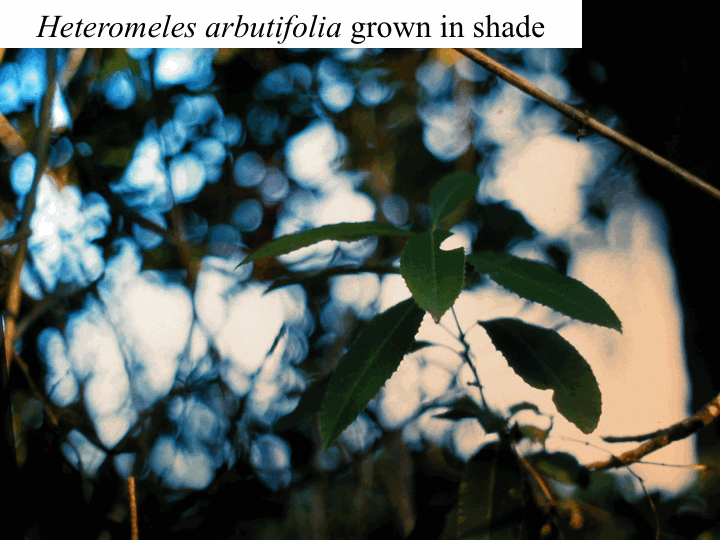Plant Responses to the Environment
[Note: Hyperlinks will open external links in new browser tabs or windows.]
Plants respond to the environment during normal growth and development, changing their shapes, characteristics, and direction of growth in ways that allow them to capture more sunlight, capture more water and mineral nutrients from the soil, etc. Common responses include phototropism in stems and petioles (growing or bending toward light), gravitropism in roots (growing toward gravity), negative gravitropism in stems (growing away from gravity), etiolation of young seedlings (growing tall and thin when in darkness), etc. These responses are important for plant survival and are common subjects of K-5 scientific investigations. The Plants-in-Motion website (http://plantsinmotion.bio.indiana.edu) contains numerous time-lapse videos of these responses, illustrating the types of investigations that can be carried out in a classroom, together with background information about these responses.
The information below, however, will focus on characteristics of plants and on plant responses that benefit plants only in certain environments. Specialized characteristics and responses that have evolved in response to certain conditions are called 'adaptations' to those conditions. Southern California has a large number of environments and habitats. The material below explains how various plant characteristics allow some species to thrive in certain areas and not in others.
The first section discusses characteristics that allow some plant species to deal with environmental challenges. The second section discusses the variation in climate and habitats found in (inland) Southern California.
Environmental Challenges to Plant Growth
Too much water
(ponds, marshes, riparian areas [=along rivers])
Problem: Flooded soil can drown roots. Roots, like animals, require oxygen to break down sugars to supply them with energy. Only the green parts of a plant produce sugar and oxygen. Roots of most plants get their oxygen from the air spaces between soil particles.
Solution: Most wetland plants have air channels inside their bodies, extending from aboveground parts of the plant down into the roots. They use these air channels to get oxygen to their roots.
Too little water and too much heat
Problems:
- Plants need water to fill the cells in their bodies, and they need water because they lose water when they open their stomata to get carbon dioxide for photosynthesis
- High temperatures can kill plant tissue (or any living tissue, if the tissue temperature is hot enough)
- High temperatures cause water to evaporate more rapidly. [This is why we are discussing "too little water" and "too much heat" as related problems.]
Solutions to having little water (having dry soil):
Grow deep roots. Usually, the surface soil dries out first and deeper soil may remain moist throughout the year. Some plants have such deep roots, they can reach a water table (the depth at which you hit water if you dig a well). These types of plants are called "phreatophytes".
Produce succulent leaves or stems. Some species, like cacti, produce succulent stems with large cells that can swell to take in and store water when it rains, then shrink as the plant loses water slowly through the dry periods. Interestingly, cacti are often not deeply rooted. Instead, they produce roots near the soil surface to absorb water from even small rainfall events that only wet the surface soil.
Drop the largest leaves during the drought. This reduces the amount of water that will be lost from leaves during the drought, protecting the root and stem from drying out. Plants that drop leaves during dry periods are called "drought-deciduous" plants. (In contrast, the more common pattern of seasonal leaf drop is for a plant to drop its leaves during the winter; those plants are called "winter-deciduous" plants.)
Have an annual life cycle. Some plant species exist in the environment only as seed during the drought. Most seeds are desiccation tolerant. That is, they can lose all their water without dying. These species avoid the drought by growing actively only during the times of the year when water is available.
Reduce water loss from the leaves by reducing leaf temperature. A plant can reduce its temperature by reducing the amount of sunlight it absorbs. This can be achieved by having light-colored leaves and/or having vertically oriented leaves. Light, reflective leaves absorb less sunlight than dark leaves. Vertically oriented leaves intercept less sunlight at mid-day than horizontal leaves.
Additionally, the soil surface may get quite hot during the summer. In such environments, plants may lose their lower leaves and produce higher leaves, further away from this hot surface, as the summer heat and drought develops.
Reduce water loss from leaves by slowing the wind that blows over the stomata. This is usually achieved by growing leaf hairs on the side of the leaf that has stomata.
The factors that affect leaf temperature and water loss from leaves can be explained in fairly simple terms and investigated in ways that link plant adaptations and physical science standards at the K-5 level.
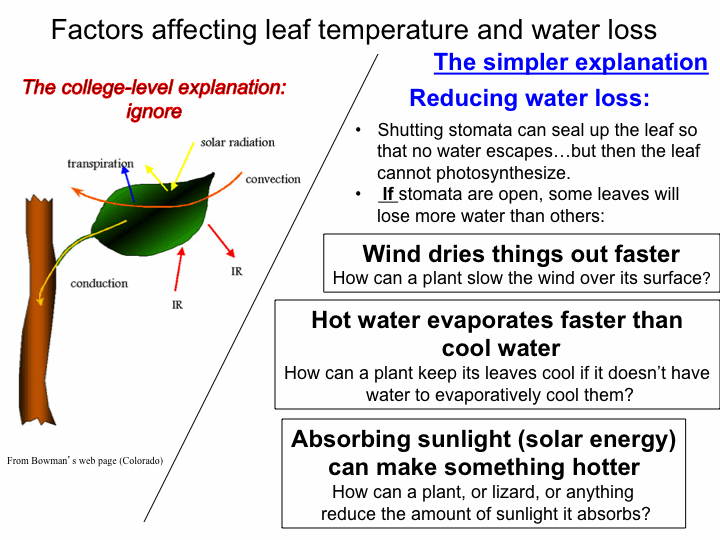
Note the dense white hairs and the cupped shape of the leaves on the California buckwheat, below. These provide a pocket of still air over the stomata that remains a little more humid than the outside air, slowing evaporation.

Additional information for college students:
Convective heat exchange is a process by which heat moves to or from a surface on moving molecules.
The direction of heat movement is from hotter to cooler. If a surface is hotter than air temperature, it will lose heat to the air through convective heat exchange. If the surface is cooler than air temperature it will gain heat from the air through convective heat exchange. If the rate of convective heat exchange is very high, the surface temperature will to stay near air temperature by rapid loss of heat to the air or rapid gain of heat from the air.
Anything that slows air movement near a surface will slow convective heat exchange. (The number of air molecules hitting the surface per unit time decreases.) Slowing air near the leaf...
- Slows convective heat heat exchange, allowing the leaf to remain at a different temperature than the air (either hotter or colder than the air). This can be good or bad for the leaf, depending on how hot or cold the air is.
- Slows the rate at which the leaf can evaporatively cool (by loss of water through stomata, then diffusion of water molecules across the still air layer surrounding the leaf).
- Slows the rate of diffusion of CO2 from the air to the stomata for use in photosynthesis. (This could be bad for the leaf,if it slows photosynthesis. It could, alternatively, be the lesser of two evils, if effets of slowed air on convective heat exchange and evaporative cooling keep the leaf at a temperature that is optimal for photosynthesis.)
Air near a leaf can be slowed by:
- Covering the leaf with a thick layer of hairs. (These hairs slow the wind near the leaf.)
- Cupping or rolling the edges of the leaf under, as above. (NOTE: Although this slows air movement on the concave side of the leaf, it exposes the convex side to greater air movement. For leaves that put their stomata only on the abaxial side of the leaf, this approach slows gases moving to and from the stomata without affecting convective heat exchange of the leaf as much.)
- Producing wide leaves. Wide leaves have thicker boundary layers than narrow leaves. This means wider leaves can get farther from air temperature than narrow leaves.
Note: The effect of leaf width on the depth of the boundary layer. The boundary layer is always thinnest at the windward edge of a surface. As the air moves over the surface, increasing numbers of molecules interact with the surface and interfere with each other, increasing the depth of the boundary layer. The image below shows a graphic representation of a boundary layer, with air (indicated by arrows) moving from left to right across a leaf. The depth of relatively still air builds up as air moves across a wide surface. A narrow leaf is amost all "edge", and the air is past the leaf before a thick boundary layer is produced.

Check your understanding:
For the next few questions, refer to the spring leaves ("early season leaves") and summer leaves ("late season leaves") of Diplacus aurantiacus, shown below.
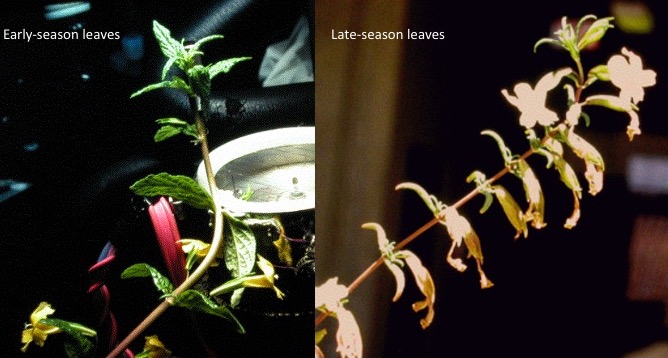
Encelia farinosa (below) produces darker leaves early in the spring, and more hairy, silver leaves later in the season. These hairs are very short but quite light colored.
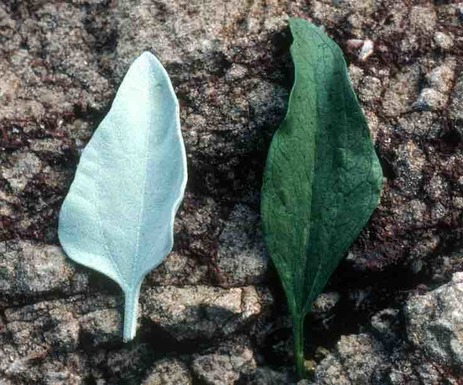
Cold temperatures, snow, and ice
Problems:
- Growth is slow when it is cold
- Cold temperatures can damage young, growing tissue
- Blowing ice crystals can damage plant tissue
Solutions:
Be short. During the winter, plants often sustain less damage if they are covered by snow than if they stick up above the snow surface and are exposed to blowing ice crystals. In the spring, when the snow first melts, daytime air temperatures are warmer near the ground than they are farther from the ground surface. (The ground absorbs sunlight and heats up, warming the air right above it.) Plants that put their leaves in this warm micro-environment can grow faster.
Be winter-deciduous. Dropping leaves during the winter and protecting growing tips with hard little scale leaves prevents damage to the leaves and buds. [Note: there is a difference between dropping a leaf in an organized manner and losing a leaf to some type of damage. Before a plant drops a leaf, it breaks down a lot of the protein in the leaf and ships it, together with many of the mineral nutrients in the leaf, back into the rest of the plant for later use. This cannot be done if a leaf is lost to ice damage, herbivory, hedge trimmers, fire, etc.]
For an evergreen plant: produce tough leaves that last for years. Evergreen plants keep leaves on the plant all year. Pine trees are evergreen. Their leaves (needles) are tough, so they resist damage and may live a long time.
Have dormant seeds that require exposure to damp, cold conditions before seeds will germinate. This prevents seeds from germinating during any late-summer or autumn rains, which would produce young seedlings that would be trying to grow during the winter. It cues them to germinate at the beginning of spring, when conditions are better for seedling survival. [In horticultural practice, exposing seeds to a period of cold, damp conditions is called "cold stratification".]
Fire
Problem: Fire can kill plants, at least the aboveground parts of a plant. [Note: Dry soil, with its small pockets of still air, provides good insulation, and belowground plant parts may live through a fire.]
Solutions:
Resprout from belowground organs like a root crown (where the root meets the stem) or a rhizome (an underground, horizontal stem). Not all plants can do this. They have to have buds below ground that can start growing to produce a new stem, and they have to have sufficient storage reserves (starch) below ground to provide energy to produce the new stems and to keep the root alive while the stem is growing.
Have a life cycle that typically involves dying down to the ground each year and producing a new shoot from belowground roots, bulbs, corms, etc. These types of plants are typically dormant during late summer, when most fires occur anyway, with only the belowground parts alive. These belowground parts are protected from heat by the insulating properties of dry soil.
Have an annual life cycle. Again, these plants are often dead by the time most fires occur in southern California, and seeds in the soil germinate, as usual, with the next rains.
For a tree: have thick, insulating bark that protects the vascular cambium (the cell layer right under the bark that produces new xylem and phloem). If the tree is tall enough that its crown (the live branches and leaves) does not burn up in the fire, protecting the cambium will insure that the tree can continue to produce new xylem, to get water to the leaves, and new phloem, to get sugars to the roots, after the fire.
Have seeds that are stimulated to germinate by either heat or chemicals in smoke. This causes seeds to germinate in the 1-2 years after a fire, when competition from other plants is low and conditions are good for seedling survival. Species that have seeds with these types of germination requirements often build up soil seed banks over years, producing seeds every year that do not germinate, but are added to the soil seed bank (a collection of dormant seeds in the soil). After a fire, fire-stimulated germination will deplete the soil seed bank (because the seeds germinated), and germination after subsequent fires will depend on whether the species has managed to replenish the soil seed bank since the last fire.
Have cones that open to release seeds after fire. Conifers (pines and relatives) that do this typically hold cones on their branches for years. Seeds are released when fires come through. Not all conifers do this.
Resource: The USDA Forest Service maintains a database of information on fire responses of different species. It does not contain information on all species, but if you are interested in the fire response of a particular species, the Forest Service's Fire Effects Information System (http://www.fs.fed.us/database/feis/plants/) is a good place to start.
Herbivory
Problem: Getting eaten can kill a plant; getting partially eaten damages it and can slow its growth. [Only fleshy fruits have characteristics that encourage animals to eat plant material: in this case, the plant benefits by having its seeds dispersed.]
Solutions:
Have characteristics that allow the plant to recover from herbivory (replace lost tissue). Plants have to have buds that are not eaten (at ground level, below ground level, or in some other protected position) and have the starch reserves to produce new tissue.
Have characteristics that discourage herbivory. Plants may be physically defended with spines, thorns, stinging hairs, etc. Plants may also be toxic or bad-tasting. [Do not eat any plant tissue you do not know is edible. We get food from plants, but we also get medicines from plants...and almost all medicines are toxic if you take too much. The castor bean seed contains ricin, one of the most toxic compounds known to man.]
Competition
Problem: Plants compete with each other for light, water and other resources. The tallest plant gets light and blocks light to shorter plants. In environments with seasonal droughts, fast-growing plants may use up surface water early, depriving later-growing or slower growing plants of water. Competition is so pervasive, we will not discuss specific characteristics that give a plant a competitive advantage over others.
However, you should know that seedlings and adult plants of a species see different environments. Babies start out small. Thus, the seedling of a large shrub or tree species starts its life seeing only the environment in the top few inches above and below the soil. At this stage, even short, fast-growing annuals like weedy grasses may outcompete a tree seedling, and no new trees or shrubs will grow where their seedlings don't survive.
Check your understanding:

